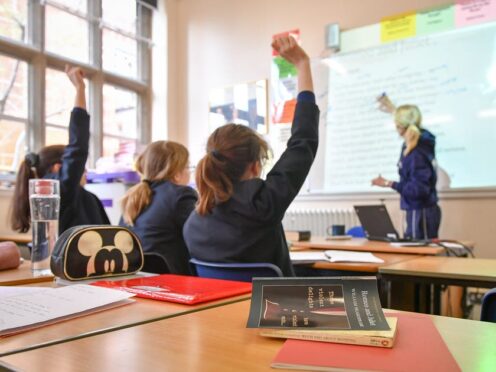The number of unauthorised pupil absences from schools in England increased during the last academic year, Government figures suggest.
Data from the Department for Education (DfE) indicates that the unauthorised absence rate rose from 2.1% in 2021/22 to 2.4% in 2022/23.
This is nearly double the rate (1.4%) during 2018/19, which was the last school year before the Covid-19 pandemic.
The figures come after a school leaders’ union chief warned this month that the social contract between families and schools had been “fracturing”.

Last month, the DfE announced a series of measures as part of its drive to boost attendance after the pandemic – including increasing fines for parents taking children out of school without permission.
The latest data from the DfE, published on Thursday, suggests that more than 150,000 pupils in England were “severely absent” during the 2022/23 year, which means they missed more than 50% of possible school sessions.
Overall, 2% of pupils were severely absent in 2022/23, an increase on 1.7% in 2022/22. This is more than double (0.8%) the number in 2018/19.
The data also suggests more than a fifth (21.2%) of pupils in England – around 1.57 million young people – were “persistently absent” during the 2022/23 school year, which means they missed 10% or more school sessions.
This is down slightly on 2021/22 when 22.5% of pupils were persistently absent – but it is still nearly double the rate in 2018/19 (10.9%).
Overall, the national absence rate has decreased from 7.6% in 2021/22 to 7.4% in 2022/23, but it remains above the pre-pandemic rate of 4.7%.
The DfE said the illness absence rate – which is the top reason for missing school – decreased from 4.4% in 2021/22 to 3.7% in 2022/23.
Unauthorised “other reasons” were 1.7% in 2022/23, an increase from 1.4%, and the unauthorised holiday rate also rose from 0.4% to 0.5% in 2022/23.
School absence fines for unauthorised absences currently start at £60, rising to £120 if they are not paid within 21 days.
But the DfE has said fines will start at £80, rising to £160, from this autumn as part of a drive to return attendance to pre-pandemic levels.
Geoff Barton, general secretary of the Association of School and College Leaders, said: “All young people have the right to an education and the fact that so many are missing more than half their time in school should be cause for major concern.
“Advertising slogans and attendance hubs are just not going to make a tangible difference to pupils who are missing days or weeks of school at a time. We have to be far more ambitious.”
He added: “If absence rates remain at these levels then the future prospects of thousands of young people are going to be jeopardised. They quite simply deserve better.”
Data on absence rates for young carers was also made available by the DfE for the first time.
It showed that nearly two in five (39%) of pupils identified as young carers were persistently absent in 2022/23, compared to 21.1% for those who had no young carer status declared.
Andy McGowan, policy and practice manager at the Carers Trust, said: “These figures should ring alarm bells in Government, showing all too starkly how being a young carer can have a devastating impact on children’s education and future prospects.”
Paul Whiteman, general secretary at school leaders’ union NAHT, said: “School leaders and teachers are doing all they can to reverse the increase in pupils who are persistently absent post-pandemic, and we are pleased to see the number of children coming back into school is moving in the right direction.
“However, absence rates are still significantly higher than before Covid and much more needs to be done to bring them down.
“The causes can span everything from illness including mental health issues, to poverty and other challenges at home, and schools alone cannot bear the burden of solving these deep-rooted challenges.
“If the Government is serious about getting more pupils back into the classroom, there must be a significant bolstering of funding for the services that support schools including children’s social care, and mental health.”
Catherine McKinnell, Labour’s shadow schools minister, said: “To benefit from a great education, children and young people must be in school and ready to learn.
“Yet we seem to be in a downward spiral when it comes to persistent and unauthorised absence, with worrying numbers of children missing vital time at school.”
A DfE spokesperson said: “Thanks to our fantastic teachers and school leaders, and our package of wide-ranging reforms designed to support schools to improve attendance, we are already seeing rapid improvement, with now 440,000 fewer children persistently absent or not attending last year alone.
“We know that some children face greater barriers to attendance, like pupils with long term medical conditions or special educational needs and disabilities, which is why our guidance ensures schools work with pupils and families to respond to each pupils’ individual needs.”
